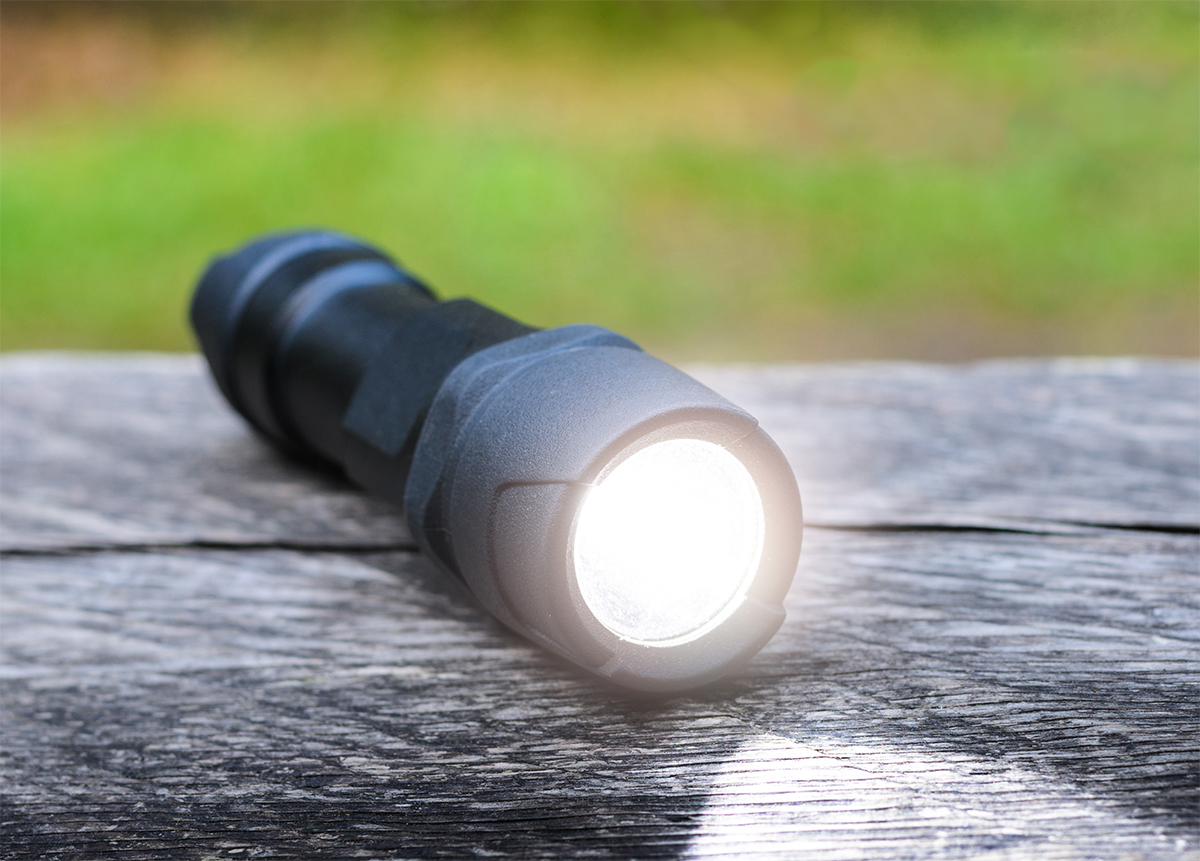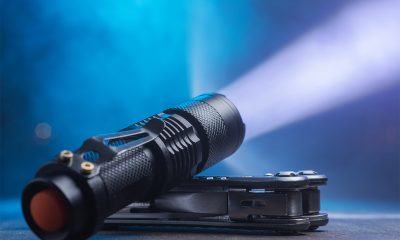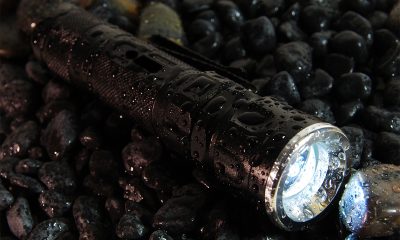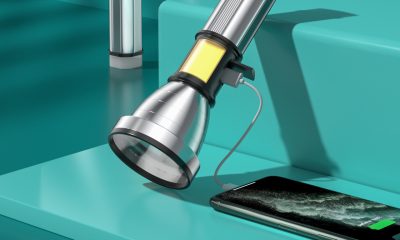Be confident of long lasting power with rechargeable batteries
A rechargeable flashlight runs on batteries capable of reversing the electrochemical reaction to restore its discharged chemical energy for a number of cycles. The fundamental justifications for the rising popularity of rechargeable flashlights lie in the convenience of using untethered power without the need for constant battery replacement as well as the performance and economy of rechargeable batteries that are difficult to be found in primary (single discharge) batteries.
The lighting industry increasingly uses rechargeable batteries to build products that withstand the most demanding conditions and deliver superior performance for law enforcement, search and rescue, recreational use, emergency preparedness, and other mission critical applications. As the continuous advancement of technology keeps pushing the boundaries of battery energy density and cycle life, the secondary battery technology has now reached a point that you can confidently count on a rechargeable flashlight without having to concern yourself with charging the batteries very often or worry about it suddenly dying on you.
Lighting and battery technologies go hand in hand
We now crossed the threshold of a new lighting revolution to embrace solid state lighting based on light emitting diode (LED) technology, which goes hand in hand with the advancements in battery technology to create a dependable, powerful portable lighting solution. LEDs make use of semiconductor electroluminescence to produce visible light. Their ability to achieve high efficiency in conversion from electrical to optical power makes good sense for battery-powered lighting applications. Minimized power consumption translates to extended run time or increased lumen output.
When compounding improved battery capacity, rechargeable LED flashlights outperform their predecessors by a wide margin. The combination of LED technology and the most sophisticated battery chemistry affords flashlight manufacturers to develop products that allows for several tens of days of continuous use or can produce tens of thousands of lumens. Rechargeable LED flashlights can shine a focused spot beam to illuminate far distances or produce a wide coverage flood light for high visibility area lighting over an extended period of time with ease.
System design and integration
A rechargeable LED flashlight integrates multiple components which must work in unison to deliver the intended performance. These components include LEDs, driver and control electronics, heat dissipation elements, housing, optics, and the rechargeable battery pack.
The LEDs are commonly high power ceramic or CSP packages that are designed with a high efficiency thermal path to enable fast heat transfer and a small source size to enable tight beam control. Luminous flux from the light source is regulated by an optical reflector or lens. Some products come with a zoom feature that provides the ability to switch the beam between the spot and flood modes. COB and mid-power SMD LEDs are usually found in products that are primarily designed for floodlighting applications.
The LED packages are generally assembled on a metal core printed circuit board (MCPCB) which thermally interfaces the LEDs to the heat sink. The heat sink is fabricated from a high thermal conductivity material and constructed with a sufficient surface area so as to maximize heat transfer to the ambient atmosphere.
The power discharged by the battery is regulated by an LED driver before it is used to drive the LEDs. As LEDs are forward biased devices sensitive to current and voltage fluctuations, the driver must provide outputs with the electrical characteristics matched to those of the LED module. The LED driver usually incorporates dimming circuitry which allows a flashlight to operate in different intensity levels or lighting modes based on the control signals handed out by the microcontroller. The microcontroller is connected to the user interface which can be a slide, push button or rotary switch. A micro-USB or USB type-C charging port is usually built into the luminaire to offer flexible charging options and the ultimate convenience of use.
Rechargeable battery
A battery is an electrochemical device that produces electrical energy via a chemical reaction between a set of active chemicals. It consists of two electrodes, the positive electrode (cathode) and the negative electrode (anode), separated by an electrolyte. During discharge, the anode undergoes an oxidation reaction which generates electrons (electrical potential energy). The electrons travel through the external electric circuit to the cathode. The cathode accepts electrons and is reduced in the process (which is known as a reduction reaction).
The electrolyte in-between provides a medium for the transfer of charge, as ions, between the electrodes, allowing a current to flow. The chemical reaction in non-rechargeable batteries, which is commonly called primary batteries, proceeds in one direction. Primary batteries are designed to go through a single discharge cycle and discarded once they are fully discharged. A rechargeable battery, which is sometimes referred to as a secondary battery, can convert chemical energy into electrical energy and vice versa. The chemical reaction inside a rechargeable battery is reversible and chemical energy can be restored after it has been converted to electrical energy.
Battery chemistry
The electrical energy that a battery can deliver and the number of charge/discharge cycles a rechargeable battery can provide are dependent on the chemistry of the electrochemical system. Several battery chemistries have been developed for use in flashlights and they include nickel cadmium (NiCd), nickel metal hydride (NiMH), and lithium ion (Li-ion). NiCd batteries perform fairly well at low temperatures, withstand extremely high temperatures and are among the most rugged electrochemical systems available. Nevertheless, these batteries are not energy dense, have a high self-discharge rate, and exhibit the so-called memory effect associated with shallow discharge/charge modes. The use of toxic cadmium results in a significant limitation on the use, transportation and collection of these rechargeable batteries. The NiMH chemistry is an improvement to NiCd. The substitution of the cadmium-based electrode with a hydrogen-absorbing negative electrode increases the battery’s energy density and eliminates the cadmium which raises toxicity concern. The memory effect is less of an issue. However, NiMH batteries have a reduced cycle life, higher self-discharge rate, and require more complex charge systems to protect the battery from overcharging and overheating. Today this battery chemistry is rapidly losing market share to lithium ion. NiMH batteries normally come in AAA, AA, C, D, 9-Volt, and 12-volt sizes.
Lithium-ion battery
Lithium rechargeable batteries have become the industry standard for portable electronic/electrical devices due to their overwhelming advantages over other battery technologies. They are the workhorses of today’s tactical flashlights, everyday carry (EDC) flashlights, handheld searchlights, headlamps and dive lights. The incorporation of Li-ion batteries redefines the portability and compactness of flashlights because their energy density of up to 300 Wh/Kg leads to a significant reduction in the required space of a battery system and the low mass of lithium contributes to a lightweight product. Lithium-ion batteries boast a long cycle life, low self-discharge rate (long shelf life), high discharge/charge efficiency, and superior tolerance to deep discharging. The memory effect is not an issue with this chemistry and periodic discharges are not needed. The high depth of discharge (DoD) and energy density of these batteries enable creation of ultra-powerful, super bright LED flashlights. The costs of lithium rechargeable batteries have plummeted over the years, which, when taking into account their extended cycle life, translates to a very competitive total cost of ownership (TCO).
Battery construction
A lithium-ion battery is typically formed of a lithiated metal oxide or lithium metal phosphate cathode, a carbon anode, and a porous polymeric separator soaked with a non-aqueous electrolyte sandwiched between the electrodes. Lithium is very reactive, which allows it to store considerable energy in its atomic bonds. As a dual intercalation system, both the cathode and the anode of a lithium-ion battery have structures that facilitate reversible insertion and extraction of lithium cations. During discharge electrons travel from the anode through an external circuit to the cathode while lithium ions migrate internally via the electrolyte and insert into atomic-sized holes in the cathode. During the charge process, the lithium ions leave the cathode and migrate back to the anode where they are reduced back to neutral lithium.
Lithium-ion batteries are generally classified according to their cathode composition. The cathode materials that can intercalate Li-ions at high potentials include lithium cobalt oxide (LiCoO2), lithium-iron phosphate (LiFePO4), lithium manganese oxide (LiMn2O4), lithium transition metal oxide (LiTMO2), lithium titanate (Li2TiO3), lithium nickel cobalt manganese oxide (NMC) and lithium nickel cobalt aluminum oxide (NCA). Cobalt-based cathodes are the most common but the use of mixed metal oxides (NMC, NCA) is expected to be huge growth in Li-ion batteries because these cathodes offer combinations of good cycle life, high thermal stability, and high energy density.
The performance of the lithium-ion battery is also dependent on the ionic conductivity of the electrolyte and the ability of the electrolyte to perform effectively over a wide temperature range. The electrolyte in a lithium-ion battery is a lithium salt in an organic solvent such as ethylene carbonate (EC), dimethyl carbonate (DMC). The electrolyte can also be a gel or polymer. A lithium-polymer (LiPo) battery differentiates itself from conventional lithium-ion batteries by using an electrolyte that has been “plasticized” or “gelled” through a polymer additive. The absence or reduced use of organic solvents allows LiPo batteries to sustain a significant amount of abuse.
Battery cells
Lithium-ion batteries come in various cell designs such cylindrical cells, pouch cells, and prismatic cells. At present cylindrical lithium-ion cells with a liquid electrolyte made up of lithium salts in a mix of organic solvents are used most widely in flashlights. Prismatic cells are similar to cylindrical cells in construction but come with a flat rectangular housing. The pouch geometry is typically designed for lithium polymer cells. Cylindrical batteries are designated by their physical dimensions—diameter by length.
The most common variant of cylindrical cells is the 18650 format which is 18 mm in diameter and 65 mm long. An 18650 lithium-ion battery is generated rated for 3.7 volts and holds a capacity ranging from 1800 mAh up to 3500 mAh. A new popular variant is 21700. The 21700 cell is slightly larger by volume than the 18650 but provides around 40 percent more capacity, which significantly extends the run time of a flashlight. Rechargeable Li-ion batteries are also found in other sizes, which include 10180, 14500, 16340, 18350, 20700 and 26650.
Despite the compelling advantages, lithium-ion batteries must be correctly designed to avoid serious safety hazards. The organic solvent electrolytes used in these batteries are flammable, have low thermal stabilities and high vapor pressures, which poses a fire or explosive risk if the battery undergoes physical damage, electrical abuse and exposures to elevated temperature. Protection circuitry is usually built into any lithium-ion battery pack to prevent the cells in the battery from overcharging, overdischarging, and overheating. The battery pack must be thermally isolated from the LED module to ensure the waste heat generated by the LEDs will not stress the vulnerable lithium-ion cells.

















Loading...